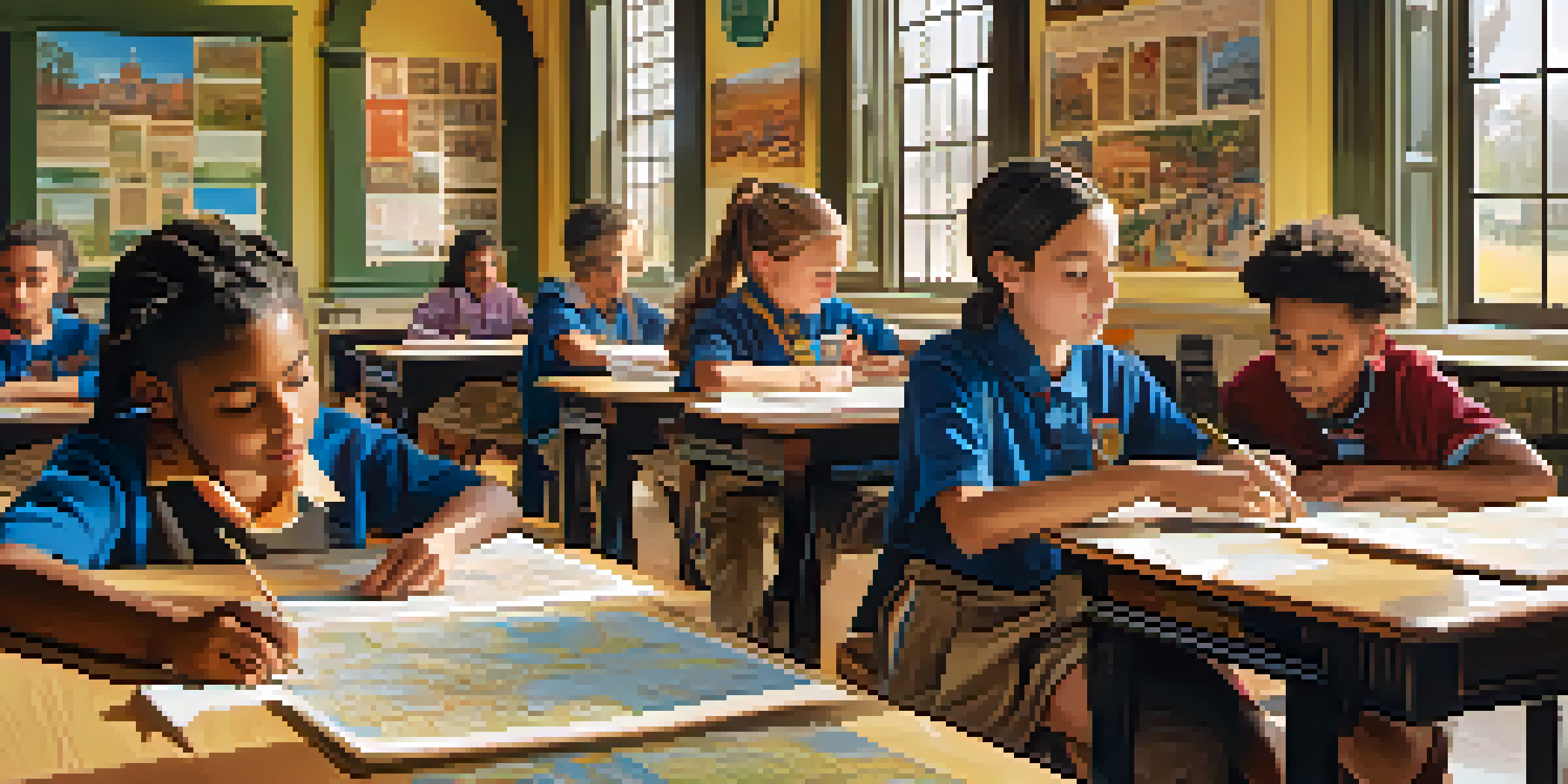Utilizing Local History to Inform Culturally Inclusive Curriculum

Understanding the Importance of Local History in Education
Local history provides a rich tapestry of stories and experiences that can greatly enhance educational content. By incorporating these narratives, educators can foster a deeper connection between students and their community. This connection not only enriches the learning experience but also validates the diverse backgrounds of students, making them feel seen and heard.
History is not a burden on the memory but an illumination of the soul.
Moreover, local history helps students understand their own identities within a broader social context. For instance, a lesson on the history of a local landmark can spark discussions about the various cultural influences that shaped it. This not only encourages critical thinking but also nurtures empathy and understanding among students from different backgrounds.
Ultimately, integrating local history into the curriculum creates opportunities for students to engage with materials that resonate with their lives. When students see their own stories reflected in their education, it boosts their motivation and investment in learning. This makes learning more relevant and engaging, leading to better educational outcomes.
Identifying Local Historical Resources for Curriculum Design
To effectively utilize local history, educators need to identify resources that are both reliable and engaging. Local museums, archives, and historical societies often have a wealth of information, including documents, artifacts, and stories that can enrich the curriculum. Teachers can collaborate with these organizations to gain insights and materials that are specific to their community's history.

Additionally, interviews with community elders and local historians can provide unique perspectives that textbooks may overlook. These firsthand accounts can offer depth and context to historical events, allowing students to explore multiple viewpoints. Incorporating oral histories can personalize learning and make it more relatable for students.
Local History Enhances Learning
Incorporating local history into education creates meaningful connections between students and their communities, enriching the learning experience.
Online platforms and local libraries also serve as valuable resources. Many libraries have digitized collections that are accessible to educators and students alike. By tapping into these resources, teachers can create a curriculum that not only informs but also inspires students to connect with their local heritage.
Creating Inclusive Learning Experiences Through Local History
When developing lessons around local history, it's essential to consider diverse perspectives. This means highlighting stories from various cultural, ethnic, and socioeconomic backgrounds. By doing so, educators can create a more inclusive environment that respects and values every student's heritage.
The more you know about your history, the more empowered you are to create your future.
Interactive projects, such as community history fairs or storytelling sessions, can bring these diverse narratives to life. Students can research their own family histories or significant local events, fostering a sense of ownership over their learning. This hands-on approach not only makes history come alive but also encourages collaboration among students from different backgrounds.
Moreover, using local history as a foundation for lessons can lead to discussions about contemporary issues and social justice. By examining historical events through the lens of today's challenges, students can develop critical thinking skills and a deeper understanding of their community's dynamics.
Engaging Students with Hands-On Local History Projects
Hands-on projects can transform the way students engage with local history. For example, organizing community walks or field trips to historical sites can provide students with tangible connections to their learning. These experiences allow students to explore their environment and uncover stories that may not be found in textbooks.
Another engaging project could involve students creating digital presentations or documentaries about local history. By researching and compiling information, they not only learn about historical events but also develop valuable skills like teamwork and communication. This project can culminate in a presentation day, where students share their findings with the community, fostering a sense of pride and belonging.
Diverse Perspectives Matter
Highlighting a variety of cultural and historical narratives fosters inclusivity and respect for all students' backgrounds.
Moreover, integrating technology can enhance these projects. Students can use apps to create interactive maps of historical sites or virtual tours of local museums. Such innovative approaches can make learning more exciting and accessible, especially for tech-savvy students.
Fostering Community Partnerships for a Richer Curriculum
Building partnerships with local organizations can provide invaluable support for educators. These collaborations can lead to guest speakers, workshops, and resources that enhance the curriculum. By working together, schools and community organizations can create a more cohesive educational experience that reflects the local culture.
For instance, a partnership with a local cultural center might lead to programs that celebrate the heritage of various communities. This not only enriches the curriculum but also strengthens community ties, as families become more involved in the educational process. Such partnerships can also provide students with role models who share similar backgrounds and experiences.
Furthermore, these collaborations can open doors for students to engage in service learning projects. By participating in community events or initiatives, students can apply their knowledge of local history in real-world contexts, deepening their understanding and appreciation of their community.
Evaluating the Impact of Local History on Student Learning
Assessing the effectiveness of integrating local history into the curriculum is crucial for continuous improvement. Educators can gather feedback from students about their learning experiences, helping to identify which aspects resonate most. Surveys, discussions, and reflective essays can provide insights into how students perceive the relevance of local history in their education.
Additionally, standardized assessments can be adapted to include local history content, allowing educators to measure student understanding effectively. By comparing these results with previous assessments, teachers can gauge the impact of local history on student engagement and learning outcomes. This data can be invaluable for advocating for the continued integration of local history in the curriculum.
Community Partnerships are Key
Collaborating with local organizations enhances the curriculum and engages students through real-world applications of their learning.
Moreover, sharing successes and challenges with colleagues can foster a collaborative culture among educators. By discussing best practices and innovative approaches, teachers can create a supportive environment that encourages experimentation with local history in the classroom.
Embracing Local History for a Culturally Rich Curriculum
Incorporating local history into the curriculum is not just about teaching facts; it's about embracing the rich tapestry of stories that shape our communities. By doing so, educators can create a learning environment that reflects the diversity and complexity of the world students inhabit. This approach not only enhances academic learning but also nurtures social and emotional growth.
As we move toward a more inclusive educational landscape, leveraging local history becomes increasingly vital. It empowers students to see themselves as part of a larger narrative, encouraging them to become active participants in their communities. This sense of belonging can inspire future generations to honor and preserve their local heritage.

Ultimately, embracing local history in education paves the way for a culturally rich curriculum that resonates with all students. By valuing diverse perspectives and experiences, we foster an environment where every student feels valued and included, setting the stage for a more equitable future.